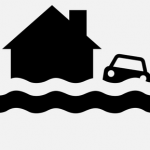
This flood symbol, created by Levees.org web designer Stanford Rosenthal, is registered as a universal icon.
The steep premium increases in flood insurance being seen by policyholders all across the nation are the direct result of the federal government’s failed levees in New Orleans in 2005.
While the worst rate spikes will occur gradually over a period of years–thanks to a bill that President Obama signed into law last month–a reported 1.1 million homeowners in flood-prone areas will still face sharp premium increases.
These overnight increases, some as high as 15-fold, have their roots in the failure of American civil engineering know-how almost nine years ago.
Before Katrina arrived in New Orleans in 2005, even the most insistent calls to evacuate did not warn that the levees could breach and fail. Such a scenario was unheard of and undreamed of.
But levees and floodwalls built by the U.S. Army Corps of Engineers, catastrophically collapsed–many at water loads well below their design heights–killing more than 1,600 and causing in excess of $100 billion in economic damages. The subsequent discovery of levee design errors were the catalyst for many national changes in policy including revisions to Corps’ levee-building and better and more uniform levee inspections by the Corps for all fifty states.
The levee breaches also revealed that flood zone maps were severely outdated and needed to be modernized. In a May 2006 keynote speech, David Maurstad, Federal Insurance Administrator and Director of FEMA’s Mitigation Division, stated at the 2006 National Flood Conference held in Philadelphia, PA:
“…In the aftermath of the 2005 hurricane season, we’re pushing forward with our 5-year, $1 billion initiative to modernize our Flood Insurance Rate Maps…”
In 2010, when the new maps were completed, they in turn were used to overhaul in the federal government’s flood insurance program, the NFIP, a rigged actuarial system that apparently did not even try to balance its books or calibrate premiums in ways that would encourage safer housing practices in areas that flood repeatedly.
And now, like a shock wave, the new rates are being rolled out. And that affects a lot of us.
Fifty-five percent of the American population lives in counties protected by levees. Thirty-nine of the nation’s fifty largest cities lie, at least in part, on a flood plain. This can be explained by the historic tendency for the populations to settle next to water for navigation, irrigation, recreation and aesthetics. This is not madness, this is life.
The failure of the Corps’ levees during Katrina was not an admirable event in American history. Nonetheless, it was a pivotal moment because the event changed America as we know it. The payouts after the 2005 floods came from the U.S. treasury which is proper since the Corps failed the people of New Orleans and is responsible for the flooding. Now all NFIP policy holders in the U.S. are paying more because the failure was a catalyst to national policy changes.





Leave a Reply